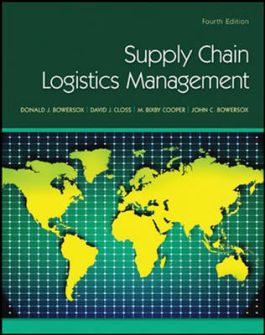EBOOK Supply Chain Logistics Management 4e
1st Edition
1309089035
·
9781309089033
© 2017 | Published: February 26, 2017
The Fourth Edition of Supply Chain Logistics Management presents Logistics in the context of integration within a firm’s Supply Chain Strategy and Operations. The framework of Supply Chain Management is initially presented thereby creating a founda…
Read More
After you purchase your eBook, you will need to download VitalSource Bookshelf, a free app. Then login or create an account and enter the code from your order confirmation email to access your eBook.
- Note: the eBook does not include access to Connect
- Access the eBook anytime, anywhere: online or offline
- Create notes, flashcards and make annotations while you study
- Full searchable content: quickly find the answers you are looking for
i. Ebook Welcome Message
ii. Preface
Supply Chain Logistics Management
1. Introduction
2. 21st-Century Supply Chains
3. Logistics
4. Customer Relationship Management
5. Procurement
6. Manufacturing
7. Integrated Operations Planning
Supply Chain Logistics Operations
8. Introduction
9. Inventory
10. Transportation
11. Warehousing
12. Packaging and Handling
Supply Chain Logistics Design
13. Introduction
14. Global Supply Chains
15. Network Design
16. Operations Analysis
Supply Chain Logistics Administration
17. Introduction
18. Collaboration
19. Performance Measurement
20. Risk and Sustainability
A. Epilogue
B. Problems
C. Cases
D. Name Index
E. Subject Index
The Fourth Edition of Supply Chain Logistics Management presents Logistics in the context of integration within a firm’s Supply Chain Strategy and Operations. The framework of Supply Chain Management is initially presented thereby creating a foundation for in-depth study of the five logistics operational components in Part Two. Challenges and strategies related to design and operational integration of logistics within a global supply chain are discussed in Part three. Part Four focuses on administrative challenges related to cross organizational collaboration performance measurement and concludes with the challenges of managing risk and achieving sustainability. An essential feature of the overall presentation is the integration of topical materials and examples into the Supply Chain Logistics value creation process. Text materials are supported by study and challenge questions as well as contemporary cases. The overall presentation integrates the discussion of information technology throughout the text. Illustrations and examples highlight how firm’s deal with operational challenges and use logistics performance to gain competitive advantage.

